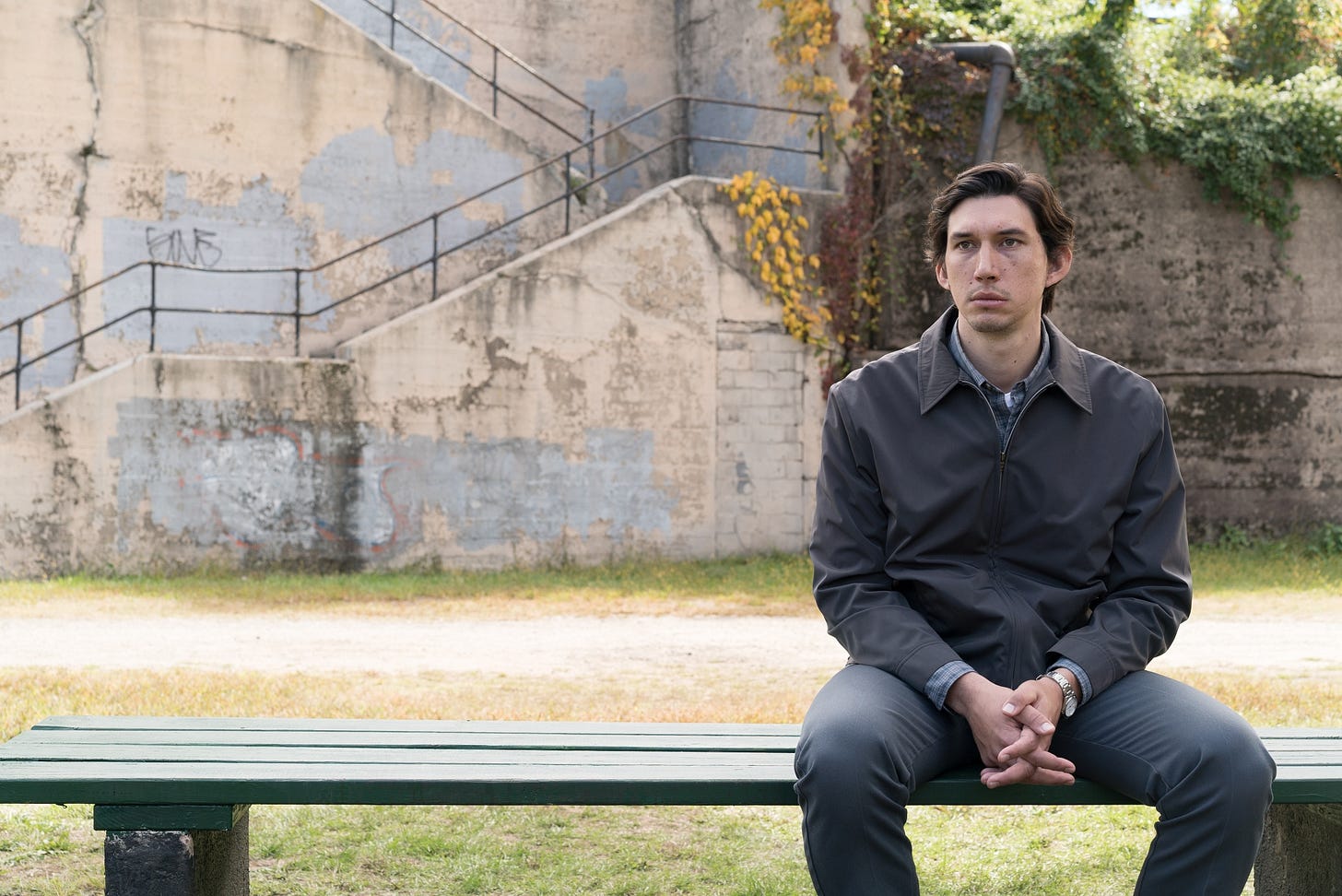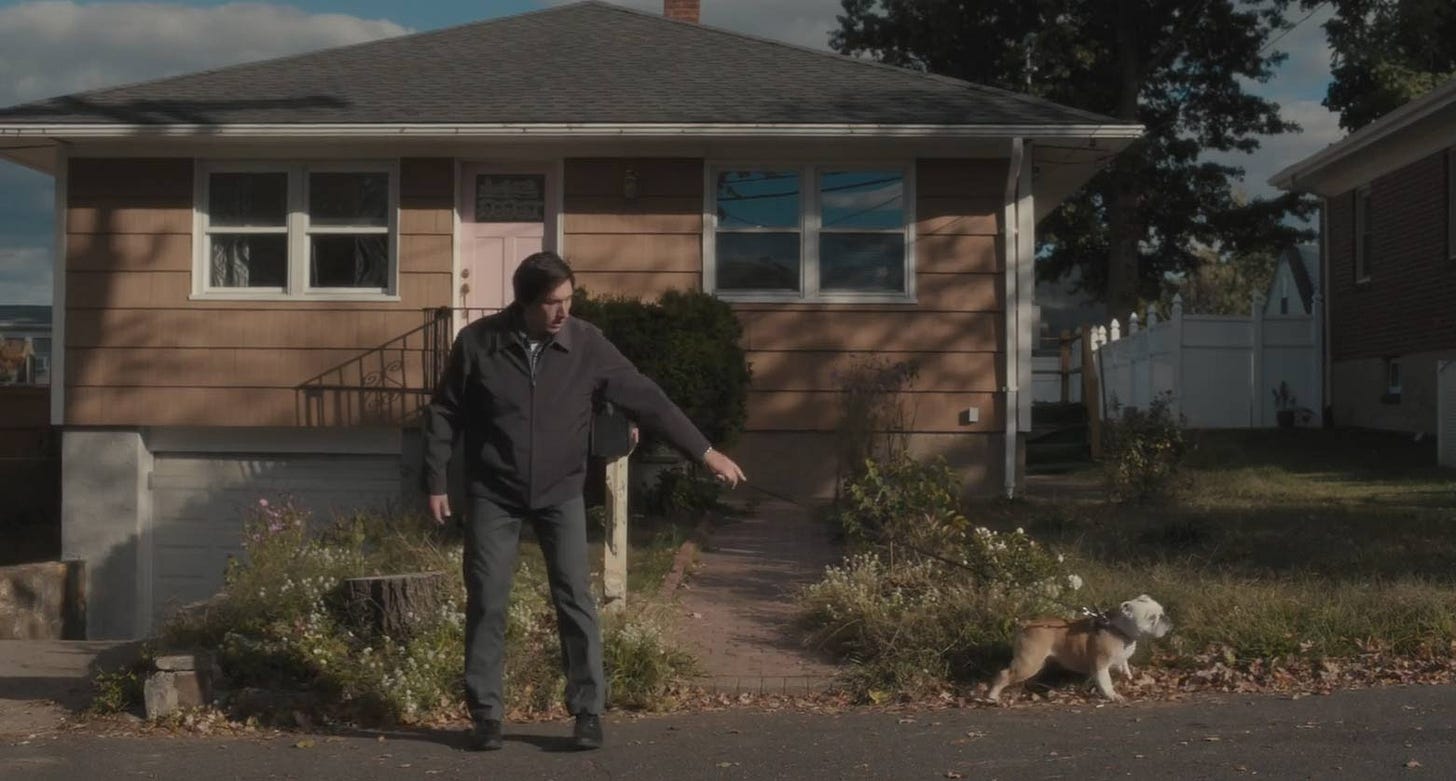Jim Jarmusch (the director of Paterson 2016) jokes about a conversation he had with someone else in the film industry about the film before production started: “wow, you’re really angling for the big bucks with this one. A poet who’s also a bus driver…”
It is a strange movie but one that left me feeling happier and more relaxed than almost any other I can recall. Rather than following a character through their struggles and feeling that empathic post-climactic triumph or relief, the viewer feels that he’s just followed the protagonist through his routine, which is pleasant and repetitive and a little dreamlike.
Paterson (Adam Driver) lives in Paterson, New Jersey and he drives a bus. His real vocation is poetry, although I doubt that he’d describe it as such. He lives in a little house with his girlfriend (Golshifteh Farahani). She’s whimsical and (we come to understand) fickle in her own aspirations but this gives her a childlike charm and she’s deeply happy with Paterson. The film opens with the caption ‘Monday’ and what follows truly is just another Monday.
Paterson begins and ends each day in the company of his girlfriend (wife?) and their relationship is one of the soothing and cheerful elements in this picture of a seemingly happy life
He eats a small bowl of cereal and considers a matchbook from a bowl on his counter. He walks through the grand and decrepit industrial brickwork corridors of Paterson. The film features many shots of the town’s step stairs, dramatic cliffs, narrow bridges, and long-quieted factories. This is a dreamlike and layered setting in Jarmusch’s lens, but we suspect that almost any place would be dreamlike and layered for Paterson. It’s not so much the environment that fascinates as it’s Paterson’s affect and wandering gaze. He arrives early to his bus seat and works on his latest poem. He listens to the passengers on his bus, whose conversations join later barroom dialogue in describing the history of the town. He stops to eat his lunch out of a little lunchbox (with a photo of his girl set into the lid). He opens the container to find a sandwich (“it was a really good sandwich”) and a Dante Alighieri postcard and a twine & paper rose. The workday driving a city bus passes easily and then he’s home, welcomed by a girlfriend (wife?) who dreams of being a successful baker one day, country music star the next, who spends hours painting their home and making curtains and who apparently has vivid and memorable dreams every night… and who loves her boyfriend (husband). This is the film: 15-20 minute synopses of day after day (each one helpfully labelled-as if to comically emphasize the sameness of them all), interwoven with poetic voiceovers and interesting street scenes of the town of Paterson and fading transitions and brief, random interactions. There are a few subplots in the film, involving his girlfriend’s dog Marvin (who seems jealous of Paterson and not overly fond of his evening walks, during which he’s left outside of the local bar while Paterson drinks his one daily beer) and some neighborhood characters but they are incidental at most.
Paterson is a story without a story. Rather it’s a serene description of a life lived by a patient, kind, and engaged man who largely exists without conflict and apparent worry. Paterson’s poetry isn’t created to some greater end or with any goal in mind. His girlfriend begs him repeatedly to copy the poems and we sense that she wants him to submit them or seek recognition but Paterson seems to be in no hurry for that.
We understand that Paterson accepts the world as it is, and furnishes his life with the mental luxuries of poetry and reflection and observation
There’s no obvious hero’s journey here… but look closer. When I watch Paterson I see a person with a great deal of wisdom living his life in a deliberate and examined way. I see an individual creating minimal strife as he passes through the world with curiosity and joy. If stories exist to teach and encourage and inspire us then Paterson is a brilliant story. It’s a Wonderful Life (1946) famously tells the story of an average suburban bank manager and father driven to existential desperation. He’s visited by an angel, who reveals all the good that his life’s decisions have indirectly done for the people all around him. Paterson tells the story of a decent and kind and thoughtful man living through an unremarkable workweek but the lesson is no less profound, if a bit less obvious.
The world is a magical and mazelike place where hundreds of individual impressions and decisions pile atop one another, becoming linked and tangled, ceaselessly, day after day. Paterson quietly reveals the wonder and beauty available to those with the care and focus to search for it, and the good that can be created in the world, rippling outward and forward through time, by living well and peacefully.
There’s a close-up shot of Paterson’s little writing area in the garage. We see two books: Paterson by William Carls Williams and Consider the Lobster, a collection of essays by David Foster Wallace. The importance of pausing to appreciate the fascination of daily life is a recurring theme in Wallace’s work. His Kenyon College commencement speech ‘This is Water’ is perhaps the best and most fulsome treatment of the theme I’ve encountered.
Here are some excerpts:
There are these two young fish swimming along and they happen to meet an older fish swimming the other way, who nods at them and says "Morning, boys. How's the water?" And the two young fish swim on for a bit, and then eventually one of them looks over at the other and goes "What the hell is water?".....
It is about the real value of a real education, which has almost nothing to do with knowledge, and everything to do with simple awareness; awareness of what is so real and essential, so hidden in plain sight all around us, all the time, that we have to keep reminding ourselves over and over:"This is water."
Learning how to think really means learning how to exercise some control over how and what you think.
The really important kind of freedom involves attention, and awareness, and discipline, and effort, and being able truly to care about other people and to sacrifice for them, over and over, in myriad petty little unsexy ways, every day.
The alternative is unconsciousness, the default setting, the 'rat race,' the constant gnawing sense of having had, and lost, some infinite thing.
Paterson would know exactly what he meant, and his life in the film seems to be a complete-either effortless and natural or organized and intentional-repudiation of the default setting. It’s a lesson worth exploring.








